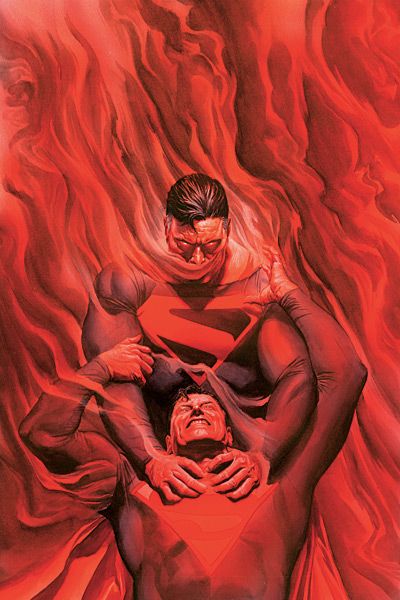Alex Ross seems to be a strangely polarizing figure in the comic book community. Some adore his photo-referenced watercolor artwork, while others feel that he paints pretty pictures but lacks the qualities of a good storyteller. Some feel that he makes the mythic characters seem real, while others think his brand of realism is garish and ridiculous. And his opinions on comic book history can be divisive as well, as he vocally supports maintaining the status quo at the expense of real change. He thinks the characters should always be the same as they were when he was a child.
All of these attitudes and opinions swirl around Ross's work, and in "JSA Kingdom Come Special: Superman" #1, we get to see Ross in full effect. For the first time in his career, Ross has written, penciled, and inked an entire comic book story.
So let's evaluate each part of his work, starting with the story. This one-shot "Special" revolves around the Kingdom Come Superman, a character who has become a prominent -- if relatively passive -- member of Geoff Johns's Justice Society. This dimensionally displaced Superman has seen his world destroyed, and he is haunted by his memories and fearful of the course of the universe he now inhabits. As the DC Universe moves, step-by-step, closer to the vision of superhero Armageddon seen in in "Kingdom Come," this wizened Superman can do little but wonder if he will live through the same events again.
Ross explores these fears, doubts, and concerns as the Kingdom Come Superman tracks down this universe's Norman McKay (the central human character in "Kingdom Come") and asks for guidance. We also learn more about the tragedy of this Superman's life, and what happened to his Lois Lane all those years ago.
It's quite a powerful story, marred only by its incompleteness. It's part of a larger "Kingdom Come"-inspired event that's running through a series of one-shots this season. So none of Superman's questions are really answered, but, then again, it's more about the questions than the answers anyway. And Ross handles Superman exceedingly well, providing a look at a powerful man whose burden is greater than anyone can ever know.
So the story is good, but how is the art?
This ranks as some of Alex Ross's best-looking work ever. I've always thought, after seeing his highly detailed pencils in various "behind the scenes" features, that his work would look quite good if it was inked instead of painted. And that's absolutely the case here. His photo-realistic style benefits from the weight of the linework, and though he uses gouache for greytones instead of traditional inking techniques, his figures have a solidity that's missing in even his best watercolor work. One of the thing that separates Ross from other photorealist comic book artists is that Ross has a great eye for the dynamic composition, and he is able to bring a nearly unprecedented verisimilitude into this story without making the character look stuff or unnatural. This comic looks absolutely great, even though the Alex Sinclair colors could be a bit more subdued. Ross doesn't need much enhancement to make his images look spectacular, and Sinclair could have held back on some of the lighting effects.
This issue also features bonus material showing Ross's highly detailed thumbnails and inking process. Looking at how tight his non-photo-referenced thumbnails are, you can see that even without the elaborate photo shoots, Ross would be one of the best pencillers in the business. That he chooses to take that extra step to make his characters seem three dimensional shows how much he cares about them.
And that care shines through, from the very heart of this story.
So ignore all of your preconceptions about Alex Ross and enjoy this story for what it is: a deeply passionate and vividly illustrated exploration of a supremely powerful man who lacks the power to help those he cares most about. It's a mythic tragedy of a superhuman sort, but one with a deeply human resonance.

